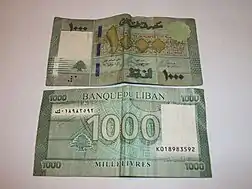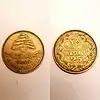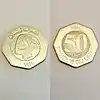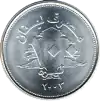Lebanese pound
The Lebanese Pound (Arabic: ليرة لبنانية līra Libnāniyya; French: livre libanaise; sign: ل.ل., ISO 4217: LBP) is the currency of Lebanon. It used to be divided into 100 piastres (or qirsh) but high inflation during the Lebanese Civil War (1975-1990) eliminated the need for subdivisions. The Lebanese Pound is also known as the Lebanese Lira.
| Lebanese pound | |
|---|---|
| ليرة لبنانية (Arabic) livre libanaise (French) | |
 Billet 1000 Lebanese Pounds, written in Arabic on one side and French on the other side | |
| ISO 4217 | |
| Code | LBP |
| Denominations | |
| Subunit | |
| 1⁄100 | piastre |
| Symbol | ل.ل. LL (international) |
| Banknotes | 1,000, 5,000, 10,000, 20,000, 50,000, 100,000 Lebanese Pounds |
| Coins | Frequently used: 250, 500 Rarely used: 25, 50, 100 |
| Demographics | |
| User(s) | |
| Issuance | |
| Central bank | Banque du Liban |
| Website | www |
| Valuation | |
| Inflation | 4.5% |
| Source | The World Factbook, 2017 est. |
| Pegged with | U.S. dollar $1 US = 1507.5 LBP[1] Black market exchange rate has diverged significantly; see article text |
The plural form of lira, as used on the currency, is either lirat (ليرات līrāt) or invariant, whilst there were four forms for qirsh: the dual qirshān (قرشان) used with number 2, the plural qurush (قروش) used with numbers 3–10, the accusative singular qirshan (قرشا) used with 11–99, and the genitive singular qirshi (قرش) used with multiples of 100. The number determines which plural form is used. Before the Second World War, the Arabic spelling of the subdivision was غرش (girsh). All of Lebanon's coins and banknotes are bilingual in Arabic and French.
Since December 1997 the exchange rate has been fixed at 1,507.5 Lebanese Pounds per U.S. dollar.[2] However since the 2020 economic crisis in Lebanon exchange at this rate is generally unavailable, and an informal currency market has developed with much higher exchange rates.[3]
History
Before World War I, the Ottoman lira was used. In 1918, after the fall of the Ottoman Empire, the currency became the Egyptian pound. Upon gaining control of Syria and Lebanon, the French replaced the Egyptian pound with a new currency for Syria and Lebanon, the Syrian pound, which was linked to the French franc at a value of 1 pound = 20 francs. Lebanon issued its own coins from 1924 and banknotes from 1925. In 1939, the Lebanese currency was officially separated from that of Syria, though it was still linked to the French franc and remained interchangeable with Syrian money. In 1941, following France's defeat by Nazi Germany, the currency was linked instead to the British pound sterling at a rate of 8.83 Lebanese Pounds = 1 pound sterling.[4] A link to the French franc was restored after the war but was abandoned in 1949.
Before the Lebanese Civil War, 1 U.S. dollar was worth 3 Lebanese Pounds. During the Lebanese Civil War the value decreased rapidly until 1992, when one US Dollar was worth over 2500 Lebanese Pounds. Subsequently the value increased again, and since December 1997 the rate of the Lebanese Pound has been fixed at 1507.5 Lebanese Pounds per US$.[2]
In August 2019, pressure on the fixed exchange rate with the U.S. dollar started, creating a parallel rate in the market. The two-rate market is a textbook case of weakening Central Bank reserves that are not able to defend the official exchange rate. Continuous financial pressures driven by unsustainable sovereign debt, high trade deficit and deposit outflows due to loss of confidence are threatening the peg for the first time since 1992.[5]
As of 1 July 2020, one U.S. dollar was quoted at over 9,000 Lebanese Pounds in the black market in Beirut.[6]
Coins
Lebanon's first coins were issued in 1924 in denominations of 2 and 5 girush (note the different spelling from post WWII coins) with the French denominations given in "piastres syriennes" (Syrian piastres). Later issues did not include the word "syriennes" and were in denominations of 1⁄2, 1, 2, 2 1⁄2, 5, 10, 25 and 50 girsha. During World War II, rather crude 1⁄2, 1 and 2 1⁄2 girsh coins were issued.
After the war, the Arabic spelling was changed from girsh (غرش) to qirsh (قرش). Coins were issued in the period 1952 to 1986 in denominations of 1, 2 1⁄2, 5, 10, 25 and 50 qirsh and 1 lira. No coins were issued between 1986 and 1994, when the current series of coins was introduced.
Coins in current use are:[7]
| Coins of the Lebanese Pound | ||||||||
|---|---|---|---|---|---|---|---|---|
| Image | Value | Technical parameters | Color | Date of issue | ||||
| Obverse | Reverse | Diameter | Thickness | Mass | Metal | |||
| Coins no longer in circulation[8] | ||||||||
| 5 قرشاً | 18 mm | 2.2 g | Copper-nickel-aluminium | Golden yellow | 1968 1969 1972 1975 | |||
| 10 قرشاً | 21 mm | 3.2 g | Copper-nickel-aluminium | Golden yellow | 1968 1969 1970 1972 1975 | |||
 |
25 قرشاً | 23.5 mm | 4 g | Copper-nickel-aluminium | Golden yellow | 1968 1969 1970 1972 1975 1980 | ||
 |
50 قرشاً ً | 24 mm | 6 g | Nickel | White nickel | 1968 1969 1970 1971 1975 1978 1980 | ||
| 1 ل.ل. | 27.5 mm | 8 g | Nickel | White nickel | 1975 1977 1980 1981 | |||
| 27 mm | 7.22 g | Nickel-plated steel | White nickel | 1986 | ||||
| Coins in circulation[7] | ||||||||
| 25 ل.ل. | 20.5 mm | 1.3 mm | 2.8 g | Nickel-plated steel | White nickel | 2002 | ||
 |
50 ل.ل. | 19 mm | 1.15 mm | 2.25 g | Stainless steel | White nickel | 1996 | |
| 21.5 mm | 1.67 mm | 3g | Nickel-plated steel | 2006 | ||||
 |
 |
100 ل.ل. | 22.5 mm | 1.80 mm | 4 g | Zinc and copper | Red copper | 1995 1996 2000 |
 |
 |
100 ل.ل. | 22.5 mm | 1.83 mm | 4 g | Steel and nickel | White | 2003 |
| 100 ل.ل. | 22.5 mm | 1.80 mm 1.60 mm |
4 g | Steel and copper | Red copper | 2006 2009 | ||
 |
 |
250 ل.ل. | 23.5 mm | 1.82 mm | 5 g | Copper and aluminium | Yellow gold | 1995 1996 2000 2003 |
| 1.65 mm | Nordic Gold | Nordic Gold | 2006 2009 2012 | |||||
 |
 |
500 ل.ل. | 24.5 mm | 2.05 mm | 6 g | Nickel-plated steel | White | 1995 1996 2000 2003 2006 2009 2012 |
| For table standards, see the coin specification table. | ||||||||
Banknotes

Lebanon's first banknotes were issued by the Banque du Syrie et Grand-Liban (Bank of Syria and Greater Lebanon) in 1925. Denominations ran from 25 girsha through to 100 pounds. In 1939, the bank's name was changed to the Bank of Syria and Lebanon. The first 250 Lebanese Pound notes appeared that year. Between 1942 and 1950, the government issued "small change" paper money in denominations of 5, 10, 25 and 50 girsh or qirsh (the change in spelling occurred during these years). After 1945, the Bank of Syria and Lebanon continued to issue paper money for Lebanon but the notes were denominated specifically in "Lebanese Pounds" (ليرة لبنانية, livre libanaise) to distinguish them from Syrian notes. Notes for 1, 5, 10, 25, 50 and 100 Lebanese Pounds were issued.
The Banque du Liban (Bank of Lebanon) was established by the Code of Money and Credit on 1 April 1964.[9] On 1 August 1963 decree No. 13.513 of the “Law of References: Banque Du Liban 23 Money and Credit” granted the Bank of Lebanon the sole right to issue notes in denominations of 1, 5, 10, 25, 50, 100, and 250 Lebanese Pounds, expressed in Arabic on the front, and French (livres) on the back. Higher denominations were issued in the 1980s and 1990s as inflation drastically reduced the currency's value.
Banknotes in current use are:
| Circulating banknotes[10] | ||||
|---|---|---|---|---|
| Image | Value | Dimensions | Main color | Date of issue |
| 1,000 ل.ل. | 156 × 67 mm | Teal | 1988 1990 1991 1992 | |
 |
115 × 60 mm | 2004 2008 | ||
| 2011 2012 | ||||
| 5,000 ل.ل. | 156 × 67 mm | Pink | 1994 1995 | |
| 140 × 70 mm | 1999 2001 | |||
| 120 × 62 mm | 2004 2008 | |||
| 2012 | ||||
| 10,000 ل.ل. | 145 × 73 mm | Yellow | 1998 | |
| 127 × 66 mm | 2004 2008 | |||
| 2012 | ||||
| 20,000 ل.ل. | 150 × 80 mm | Red | 1994 1995 2001 | |
| 130 × 72 mm | 2004 | |||
| 2012 | ||||
| 50,000 ل.ل. | 150 × 80 mm | Blue | 1994 1995 1999 2001 | |
| 140 × 77 mm | 2004 | |||
| 2011 2012 | ||||
| 100,000 ل.ل. | 161 × 90 mm | Green | 1994 1995 1999 2001 | |
| 147 × 82 mm | 2004 | |||
| 2011 2012 | ||||
| For table standards, see the banknote specification table. | ||||
All current notes feature an Arabic side with the value in Arabic script numerals of large size. The other side is in French with the serial number in both Arabic and Latin script and in bar code below the latter one.
Devaluation
Since September 2019, the exchange rate has forked into multiple distinct rates due to Lebanon's banking sector collapse. Within 6 months, 6 distinct Lebanese Pound rates were defined against the US Dollar, officially and unofficially. On October 1, 2020 they were valued at:
See also
| Current LBP exchange rates | |
|---|---|
| From Google Finance: | AUD CAD CHF EUR GBP HKD JPY USD |
| From Yahoo! Finance: | AUD CAD CHF EUR GBP HKD JPY USD |
| From XE.com: | AUD CAD CHF EUR GBP HKD JPY USD |
| From OANDA: | AUD CAD CHF EUR GBP HKD JPY USD |
| From fxtop.com: | AUD CAD CHF EUR GBP HKD JPY USD |
References
- "About Banque du Liban | History of Banque du Liban". www.bdl.gov.lb. Retrieved 13 June 2016.
- "Economic & Financial Data". Banque du Liban. Archived from the original on 2013-03-12. Retrieved 2013-02-10.
- "Lebanese banks raise USD withdrawal rate to 3,850 pounds/dollar". Reuters. 29 June 2020. Retrieved 1 July 2020.
- "Payment Media, Banknotes and Coins – The Historical Development of the Lebanese Pound". Banque du Liban. Archived from the original on 2008-12-26. Retrieved 2008-12-31.
- "Lebanese Lira Rate & History". The961. Retrieved 2020-12-27.
- "Lebanese pound plummets to new low as airport reopens". The Daily Star. July 1, 2020. Retrieved 2020-07-01.
- "Coins in Circulation". Banque du Liban. Retrieved 26 September 2020.
- "Coins Out of Circulation". Banque du Liban. Retrieved 26 September 2020.
- Linzmayer, Owen (2012). "Lebanon". The Banknote Book. San Francisco, CA: www.BanknoteNews.com.
- "Banknotes in Circulation". www.bdl.gov.lb. Banque du Liban. Retrieved 26 September 2020.
- "Daily (official and unofficial) exchange rate development between mid October 2019 and August 20 2020" (PDF). WFP. 20 August 2020. Retrieved 1 October 2020.
- "Lebanese Lira Exchange Rates & Values against the US Dollar". LebaneseLira.org. 1 October 2020. Retrieved 1 October 2020.
- Krause, Chester L.; Clifford Mishler (1991). Standard Catalog of World Coins: 1801–1991 (18th ed.). Krause Publications. ISBN 0873411501.
- Pick, Albert (1994). Standard Catalog of World Paper Money: General Issues. Colin R. Bruce II and Neil Shafer (editors) (7th ed.). Krause Publications. ISBN 0-87341-207-9.